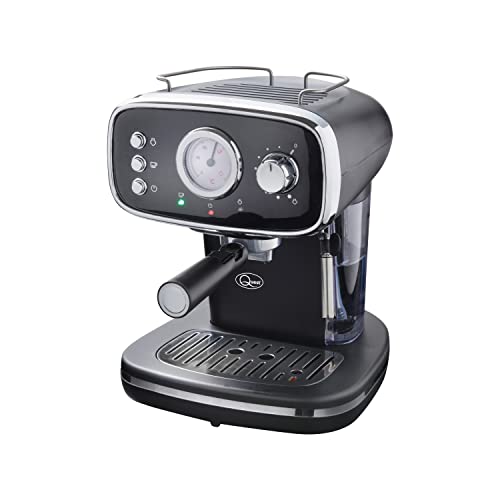How to Make Espresso Machine Coffee
Espresso machines can create an excellent cup of coffee, but they require more care and setup than a regular coffee maker. It also requires you to grind and make your own coffee.
Pressure is the key to making espresso. Here's how an espresso machine works: a heating vessel heats water to the ideal temperature, then it pushes it through the grounds before pouring out the spouts.
Temperature
Espresso is made by forcing hot water under pressure through finely roasted coffee. The temperature of the water is crucial to the final shot. Temperatures that are too low can result in a absence of flavor compounds. Temperatures that are too high can result in excessive extraction, which could result in a bitter or burned taste.
espresso machines www.coffeee.uk for espresso is between 195 and 205degF. This temperature can be achieved by using a grouphead designed to maintain the same temperature and stability throughout the process of brewing. The E61 is the most sought-after group head since it provides the ability to stabilize temperature, pre-infusion and lever control.
When altering the espresso machine to accommodate different roasts and brew ratios it is crucial to take into consideration the effect of temperature on the extraction yield and crema. The ideal temperature will differ depending on the roast and beans. However the general rule is that lighter roasts with higher brew rates require higher temperatures. A high-quality thermocouple is vital to maintain the temperature at a constant level.
Pressure
During the brewing process espresso machine coffee is pushed through finely ground and tamped grounds. This triggers chemical reactions that extract flavors oils, flavors and other soluble components from the beans. The resultant beverage is usually richer and more flavorful than regular coffee.
The ideal espresso machine's pressure should be nine bars equivalent to the atmospheric pressure at sea level. The soluble components in the espresso bean are best extracted at this pressure.
However certain espresso machines advertise as high as 20 or 15 bars of pressure. Although these machines can reach these levels of pressure however, they might not be capable of maintaining the pressure during the extraction.
One bar of pressure equals to 32 pounds per square inch (PSI) of the tire of a car. It's more than four times the amount of pressure that a professional cyclist uses when filling their bicycle tires. Any serious home barista must to be able manage the pressure of their espresso machine to produce consistent espressos.
Water

Water is the most important ingredient to a perfect cup of espresso. The correct water will assist your beans in reaching their full potential. Using the wrong water can cause issues such as blocked pipes or even damage your expensive espresso machine.
For the best extraction of espresso You should select a natural spring with high mineral content. This water will elevate the flavor of your espresso without the chalky mineral traces that come from tap or bottled water. This is an excellent alternative to distilled water or reverse osmosis. It can be too purified and cause taste issues.
You should not utilize a water filtration device that removes too much mineral content from the water you drink. This can result in flavor and extraction problems. A great option is to purchase a water test kit which will provide you with the water hardness in your area. This can then be used to identify an filtration system that can give you the correct specifications for the water in your espresso machine.
Beans
Most coffee lovers tend to be very involved in the entire process of making espresso. They get obsessed about a range of factors, such as temperature, water pressure, and viscosity. If one variable is even slightly off, the whole shot might taste bad.
The beans used are the most important aspect when it comes down to espresso. Many people believe that only certain types are suitable for espresso. Although certain beans are suitable for specific uses however, any coffee bean that has been roasted can be used to make espresso. Espresso beans are roasted longer than regular coffee beans, tipycally beyond the second crack. This makes them appear darker and makes them more water-soluble.
The best espresso beans are typically medium roasted or dark roasted, giving the espressos their distinctive richness and vigor. Lightly roasted beans can be used to make fantastic espresso, particularly when they are ground prior to use for convenience in an espresso maker.
Milk
Espresso and milk are a classic pairing. The coffee doesn't just increase energy levels, but the steamed milk helps to balance the bitterness of the espresso and provides a delicious creamy flavor. This is one of the best pairings for a meal!
When you are choosing an espresso machine capable of making latte, or a cappuccino as well, you should consider how easy it is to use. A lot of the top machines come with a jug for hot or cold milk, as well as a steam wand. They also come with a portafilter for pulling the shot. Some models also come with an integrated grinder as well as a tamper and a frother.
The steam wand should be purged before making use of it for the first time in a day (or after each cup of espresso) to remove any condensed water. This process takes about 30 seconds and is crucial to keep your machine operating smoothly. If you don't cleanse, it can cause bitter taste and/or accumulation of bacteria that could alter the flavor or aroma of your beverage. It's easy to do and should form part of your regular maintenance schedule.
